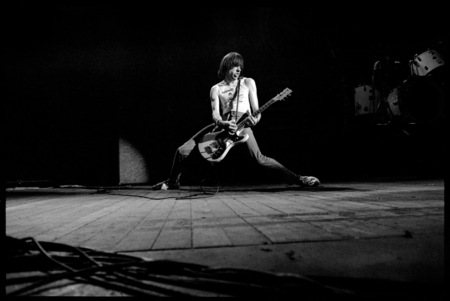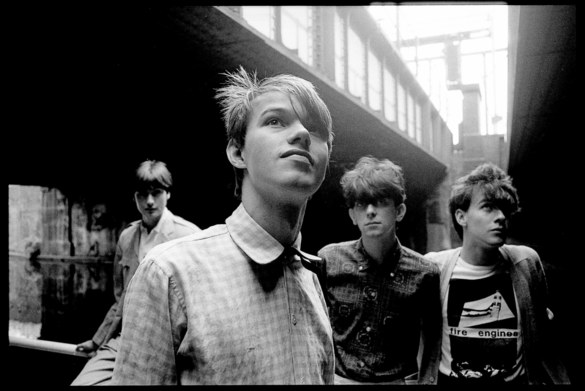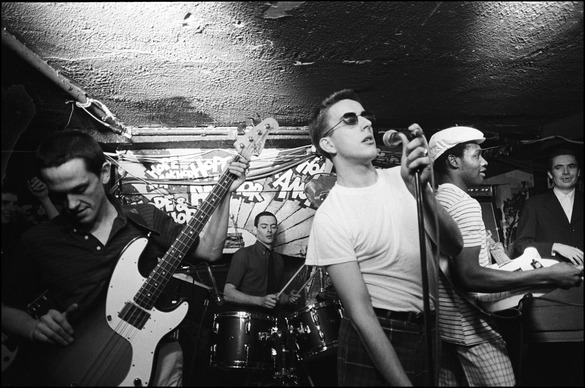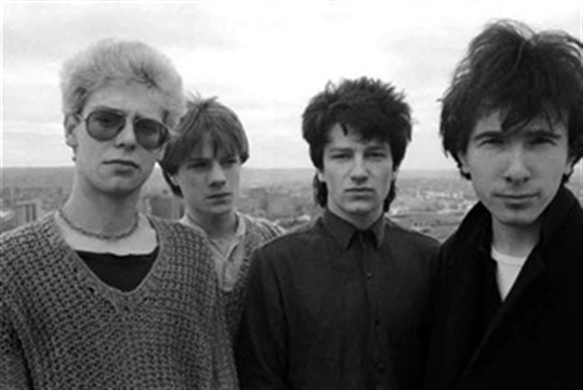David Corio began his professional career in 1978 taking photographs for New Musical Express, followed by The Face, Time Out, and Black Echoes, covering a wide range of music and portraiture.
-
David Corio recalls: "I always felt a bit sorry for Adam Ant. He had been around at the beginning of the punk movement collaborating briefly with Jordan and Malcolm McClaren but he never seemed to quite fit the right mould. His music was hugely popular for a time with 11 singles hitting the charts over a 5 year period. Adam & The Ants videos were flamboyant fun and got massive amounts of air-time as music videos were comparatively new and MTV was just starting up but the pantomime pirate imagery had become more important than the music. The use of two drummers for live performances gave the band a powerful set up using the Burundi-style drum beat and he was a captivating live performer but as his audience became younger other music seemed to be overtaking him. New wave and New Romantic music scenes were coming along and suddenly Adam & the Ants were old hat and out of fashion. This photo was taken when they were at the peak of their commercial success Stand & Deliver and Prince Charming were released at this time which would both reach number one in the UK charts but within a year the band had split up. More recently his career has had several ups and downs from having a successful autobiography published and acting in several films to being arrested on a number of occasions and having several prolonged stays in psychiatric wards. In 2009 he started perfoming live again with various line-ups and there are rumours that he has recently started to record again."
-
David Corio recalls: "Billy Braggs musical career was just beginning to take off when I met up with him in west London. If possible I try and find a few suitable locations before I do a shoot which can put a subject at ease and also help to create good compositions. A demolition site seemed ideal for Billy Bragg at the time as he was heavily involved in political causes on the left wing trying to break down the stranglehold that Margaret Thatcher held over the country. His second album Brewing Up With Billy Bragg came out later in the year and continued on his anti-war themes and his discontent with the British tabloid press. He has remained politically active backing the 1984 miners strike and helping to form Red Wedge a musicians alliance to encourage young people to vote for the Labour Party. He has also promoted tactical voting particularly in Dorset where he now lives but surprisingly announced he was voting for the Liberal Democrats in 2010 and must have been unpleasantly surprised when they formed a political alliance with the Conservative Party to gain power."
-
David Corio recalls: "This was Bob Marley’s last London concert and one of his final shows before his untimely death 10 months later. I’m sure not many people knew of his illness as he performed a stirring two hour show that afternoon. This venue has a lake in front of the stage and as I didn’t own a really long lens I waded into the lake with my camera and a few rolls of film in a carrier bag. I got to the front of the stage where the water was about 4 feet deep and shot from there. Bob performed in an almost hypnotic trance. Of the three rolls I shot I think he has his eyes open in only two of the photos. He was a shaman dancing, his locks all over his face throughout the show."
-
David Corio recalls: "This photo of Bruce Springsteen was taken from the audience - I hadn’t got a photo pass but was lucky enough to get a ticket for the show and I managed to get near to the stage at the huge Wembley Arena. Apart from a couple of shows in 1975 this was the first big concert in Europe for ‘The Boss’ as he is affectionately known. He was famous for his energetic sets and this show lasted for three hours and he didn’t stop moving for the entire show. He climbed up onto the speakers, leaped across the stage and pulled girls out from the audience to dance or sing with him. Springsteen supports many social causes, keeps to his working–class roots and speaks out very strongly on political issues. He has donated money to war veterans groups, endorsed Barack Obama early in his political campaign and most recently took part in fund-raising events for Haiti after the earthquake. He still lives in New Jersey where he was born - his 1973 debut album ‘Greetings From Asbury Park’, was named after the run-down sea-side resort where he still occasionally plays the tiny Stone Pony Club (capacity - 775 people) . A contrast to the 137,000 people that were at the Glastonbury festival when he performed in 2009!"
-
David Corio recalls: "NME had voted De La Souls 3 Feet & Rising as the best album of 1989 and they asked me to meet up with the trio as they were promoting their third release Buhloone Mindstate. I got picked up in a minivan in mid-town and whisked uptown. Throughout the whole journey I didnt have a clue what they were talking about. They were well known for their witty lyrics,quirky skits and eclectic sampling but it was as if they were talking in a totally different language interspersed with hysterical laughter. We piled out next to the Apollo Theatre in Harlem and I had to marshall them together to fit them all in the frame with part of the famous venue in the background. They seemed barely aware that I was photographing them but it made for an easy, laid-back photo-shoot."
-
David Corio recalls: "This is Dexys Midnight Runners before they had a major label or hit record. I spent a few days in Birmingham with them before seeing the band perform or knowing anything about their music. When I finally saw them live in London a few weeks later they blew me away. With a mighty horn section and stomping rhythm tightly controlled by lead singer Kevin Rowland, this was one of the most powerful shows I had the good fortune to attend. Journalist Gavin Martin and I met up with them several times always in working-mens cafes for endless cups of tea and to hear Kevins philosophy on life. Kevin Rowland controlled the band completely - banning alchohol and enforcing a strict dress code of white tees, donkey jackets or leather coats and woolen docker hats. Somehow he managed to persuade the others into going for regular early morning runs, long before jogging became fashionable. Despite their immense talent Dexys Midnight Runners werent suited to the commercial music scene and their albums didnt sell as well as they should have. Each new album was always a surprise as they invariably came up with a different musical style. A few years after taking this photo I got on a plane in Lisbon after photographing Rick Wakeman. I was wearing espadrilles with my hair in a pony-tail. And there already on board was the whole band - coincidentally all wearing the same espadrilles and sporting pony-tails."
-
David Corio recalls: "I'd met Feargal as he left a rehearsal room on Holloway Road in north London late one evening. I shot some portraits of him under a street light as I didnt have any lights or flashgun with me. It occurred to me as we passed a launderette that this was the best lit location in sight and thats how this photo happened. It was a quiet session as Feargal didnt speak much and I tend to go with the subjects mood. The Undertones were a great pop punk band from Derry in Northern Ireland and Feargals distinctive quavering voice made them stand out. The bands first album The Undertones featuring the classic song Teenage Kicks John Peels favourite song of all time had been released not long before I took this picture."
-
David Corio recalls: "I first met Ian Dury in my sister’s flat in Wandsworth in 1977. He was playing drums with Wreckless Eric who was my sister’s boyfriend. I was 17 and Ian was 34. He was very friendly and encouraged me to take music photos. Artistic and knowlegable with a unique sense of humour and a wicked laugh, Ian gave me a lot of confidence to do what I wanted to do. He often spoke in Cockney rhyming slang. Having had polio from an early age he sometimes refered to himself as a raspberry. Raspberry ripple = cripple. I was fascinated and thrilled to know him. He also introduced me to the highly regarded graphic designer Barney Bubbles who was also a big influence. I went to many of Ian’s shows. He was an extraordinary performer and there was always a sense of mayhem on the stage. He’d always invite me backstage to take photos and this wasn’t posed at all. He was dressed as he was about to go onstage with the Blockheads. Unlike many performers he didn’t show any nerves before performing but would normally hang out with his old friends saxophonist Davey Payne and his handler/minder the former burglar Spider."
-
David Corio recalls: "One-two-three-faww! I think this picture captured the persona of Johnny Ramone – requisite Ramones T-shirt, guitar slung impossibly low, drainpipe jeans plastered on skinny long legs splayed wide and all capped by a contemptuous sneer. Johnny Ramone’s super-fast buzzsaw guitar had a huge impact on the punk scene and he could make a two-minute song sound like an epic." The Ramones were synonymous with CBGB’s, the legendary New York club on The Bowery that kickstarted the careers of many US punk bands. Johnny died of prostate cancer in 2004.
-
David Corio recalls: "Julian Cope has had an unconventional career. He first achieved fame and success when his band Teardrop Explodes’ single ‘Reward’ reached the top ten in 1981 but after three years and three albums they were to split up with Cope starting off on a solo career. His strong political and religious views along with hallucinogenic experimentations have caused friction with various labels over the years and he now mainly records and promotes his own releases independently. He has become a successful author writing books on the history of German and Japanese rock music (‘Krautrocksampler’ & ‘Japrocksampler’) but has probably become best known as an acclaimed archeologist with his two books ‘The Modern Antiquarian’ and ‘The Megalithic European’ – a subject close to my heart. The photo session was done in conjunction with his ‘St Julian’ release in a bland executive boardroom. The only light was a single strip light and to get more atmospheric lighting we both stood on the table for a better vantage point. He was very easy to photograph as every time I took a shot he automatically moved into a different pose – mugging for the camera one minute or looking vulnerable the next."
-
David Corio recalls: "Orange Juice were a quintessential indie band signed to Postcard Records hailing from Glasgow. They seemed somehow out of place in London wearing shorts on a summers day so I took them to the canal which seemed to be more fitting for their image. They had a post-punk sound but combined jangly guitars reminiscent of disco band Chic with funky bass lines. Rip It Up released in 1983 was their only top forty hit but along with label stablemates Josef K they have been regarded as a big influence on a host of more recent guitar-driven bands like Franz Ferdinand and The Drums." In 2005 lead singer and songwriter Edwyn Collins suffered a double brain haemorrhage. He has undergone a lengthy programme of neurological rehabilitation and has recently gone back to recording and occasional live performances.
-
David Corio recalls: "When I photographed Richard Butler in the lift of his record label CBS his band The Psychedelic Furs were in a musical transition from being an arty new wave band with punk overtones to creating a straightforward rock sound that was less pretentious and would give them mainstream success particularly in the US.The Psychedelic Furs album Talk Talk Talk was just released at this time and creating a buzz. I wasn't a fan of their music and that can sometimes make it difficult to be inspired when it comes to taking photographs. I would sometimes get musicians to collaborate in the photo shoot by getting them to produce their own lighting. I had the flash gun attached to a long lead and gave it to Richard to point at himself or wherever he wanted to. It can create interesting shapes and shadows although as this was done in pre-digital days I didn't know what I was getting until I developed the film. Highlights can get burnt out, flare can be a problem and the angles may not always be particularly flattering but that is part of the fun of it. He was a willing participant striking different poses and tugging his shirt and hair. I don't think we said a word to each other during the whole shoot."
-
David Corio recalls: "This was Public Enemy's first day in London on their debut European tour. They were plugging their first album Yo! Bum Rush The Show. Due to massive press interest and their very crowded schedule I was allocated a session with them on a foggy November morning. Their gangsta poses and Black Power salutes for the camera seemed incongruous in a Hyde Park criss-crossed by suited men striding to work, dog walkers and early morning joggers. What concerned them most that morning was the dearth of McDonalds en route from the airport. They wanted reassurance that there was at least one somewhere in England. I told them in my most reassuring voice that I thought Id heard of a branch up north but I wasnt certain where, which they naturally refused to believe. Over the years the magnitude of Flavor Flavs clock increased in proportion to his fame. When I took this photo, his present incarnation as a reality TV star was unimaginable. It is as well he didnt become as celebrated as Michael Jackson or hed have Big Ben hanging around his neck."
-
David Corio recalls: "The Pogues frontman had a reputation as a hard-drinking man so I was surprised when I was asked to photograph Shane at 11am in a fancy French restaurant in Camden Town. When I arrived Shane was already there for the interview. He had by then established a format for excessive consumption - a swig of Guiness followed by another swig from a large tumbler of brandy, then a spoonful of French Onion soup, a drag on a cigarette and back to the Guiness in a rapid rhythmic sequence. He didn't miss a beat. I took him outside for the photo and he was remarkably clear-headed, eloquent and witty. I asked him if he could take his sunglasses off but he refused in no uncertain terms."
-
David Corio recalls: "The former 19th century steam engine repair shed was a circular venue that had been previously known for hosting acts like Jimi Hendrix and Pink Floyd with psychedelic light shows in the 1960s and it still had an alternative hippy feel even when punk was in full force. The Roundhouse had unusual line-ups and this show featured Dire Straits opening the bill followed by Slaughter & The Dogs and Talking Heads headlining." Talking Heads’ debut album ‘Talking Heads 77’ was one of the early new wave albums that was quite different and more sophisticated than most of the punk music coming out at the time. This would later be labelled post-punk. Their first single ‘Psycho Killer’ was a hit and featured Tina Weymouth’s distinctive heavy bass line and David Byrne’s jagged guitar sound. They later developed a heavier rhythm using a mix of funk and world music influences and Tina Weymouth also formed the more hip hop –influenced Tom Tom Club with Talking Heads’ drummer Chris Frantz. Talking Heads finally split up in the late 1980s. Although they reformed briefly when they were inducted into the Rock & Roll Hall of Fame Tina Weymouth was quoted as saying that David Byrne was ‘a man incapable of returning friendship’. Don’t expect any reunions in the near future!
-
David Corio recalls: "The Nashville Room was a big grotty room on the corner of Cromwell Road and North End Row in West Kensington. It was a music mecca for about five years where many bands including the Sex Pistols, The Police, U2 and Joy Division got some of their first shows. This was an early gig for The Pretenders. I hadn’t been commissioned but I was curious about the band as there had been so much buzz about them. I like this photo for its structure and light as much as for Chrissie’s pose. The photo was recently published again by a US magazine accompanied by Chrissie’s memories. Although she could no longer remember where her Gibson SG guitar had vanished to, she recalled that she was wearing her plastic Fiorucci trousers that night. Sadly the two guitarists in the photo Pete Farndon and guitarist James Honeyman-Scott died from drug overdoses a few years after The Pretenders 1979 debut hit single ‘Stop Your Sobbing’."
-
David Corio recalls: "The Hope & Anchor was legendary during the pub rock and early punk days to be daring enough to support new unknown bands. The pub had been threatened with closure by the local council so various bands that got their early gigs there put on a series of benefit shows in the tiny basement. Joy Division and Madness had played on previous nights and these were the hottest tickets in the hottest venue in town. For the whole band to fit on the stage was an accomplishment. Not only was it tiny but by now the band that had spearheaded the Two Tone movement was beginning to fracture. Keyboardist Jerry Dammers was at loggerheads with other members of the band but sometimes creative tensions can produce great performances. The problem for me was trying to get as many of the band members in the frame as they danced around and I tried to avoid being crushed against the front of the stage. When the whole audience is bouncing up and down sometimes you have to snap away and hope for the best. This one came out pretty well considering."
-
David Corio recalls: "The show opened with a specially designed set - the exterior of an old bar straight out of a Western, the “street” lit by a single street lamp. Tom walked on stage and leaned nonchalantly against the lamp post, a burning cigarette dangling between his fingers. After a few songs and cigarettes, he wandered over to the piano and began to play. Although the whole set looked beautiful, it was a nightmare to photograph. Darkness was obviously the design theme. There was just one light above Tom at the piano and the brim of his trilby kept his face in shadow. Fortunately Tom Waits makes some great dramatic gestures when he performs - in this photo the light off the back of his hand and the keyboard reflected onto his face and I was able to get this shot."





















